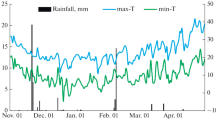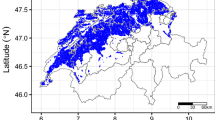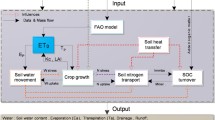Abstract
Intensified use of nitrogen based fertilizers in agriculture has resulted in a significant increases in soils and groundwater nitrate concentrations all over the world. Here we propose a new coupled model which describes the physical transport and biogeochemical dynamics of the water and nitrogen compounds in a soil-water-plant-groundwater system. Our model takes into account water infiltration into an unsaturated porous medium, the complex biogeochemical cycle of nitrogen in soils, nitrate leaching from the agricultural system toward the aquifer’s water table, and the dispersion of nitrates in the groundwater. We calibrate our model and analyse the influence of soil type, precipitation or irrigation regime and fertilization schedules on leaching to groundwater as well as the temporal and spatial evolution of the nitrate pollutant plume in the aquifer. Simulations indicate that in order to achieve high crop yields while minimizing nitrogen loading to soils and groundwater we need to create an optimal balance between the amount of chemical fertilizers and water applied to crops on one hand, and the amount of nitrate and water used by plants on the other. We find that medium soils are more suitable for a sustainable corn production than coarse soils, ensuring both higher yield and less nitrate pollution of the aquifer. Regardless of soil type and irrigation schedule, a gradual fertilization throughout the plant life cycle reduces the potential for leaching and aquifer pollution. For medium soils, a more modest irrigation schedule results in more nitrate available for crops and less net leaching to the groundwater.






Similar content being viewed by others
References
[SWRCB] State Water Resources Control Board (2013). Recommendations Addressing Nitrates in Groundwater. Report to the Legislature. 20 Feb 2013, 70 p.
Antonopoulos VZ (2001) Simulation of water and nitrogen balances of irrigated and fertilized corn-crop soil. J Irrig Drain Eng 127:77–83
Cannavo P, Recous S, Parnaudeau V et al (2008) Modeling N dynamics to assess environmental impacts of cropped soils. Adv in Agron 97:131–174
Cassman KG, Dobermann A, Walters DT, Yang HS (2003) Meeting cereal demand while protecting natural resources and improving environmental quality. Ann Rev Environ and Resour 28:316–358
Costa JL, Massone H, Martinez D, Suero EE, Vidal CM, Bedmar F (2002) Nitrate contamination of a rural aquifer and accumulation in the unsaturated zone. Agric Water Manag 57:33–47
Fetter CW (1992) Contaminant hydrogeology. Macmillan Publishing Company, New York, pp 54–73
Gardenas AI, Hopmans JW, Hanson BR et al (2005) Two-dimensional modeling of nitrate leaching for various fertigation scenarios under micro-irrigation. Agric Water Manag 74(3):219–242
Gelhar LW, Welty C, Rehfeldt KR (1992) A critical review of data on field-scale dispersion in aquifers. Water Resources Res 28(7):1955–1974
Geng QZ (1988) Modélisation conjointe du cycle de l’eau et du transfert des nitrates dans un système hydrologique. Dissertation, ENSM de Paris
Geng QZ, Girard G, Ledoux E (1996) Modeling of nitrogen cycle and nitrate transfer in regional hydrogeologic systems. Ground Water 34(2):293–304
Greenwood DJ, Zhang K, Hilton HW et al (2010) Opportunities for improving irrigation efficiency with quantitative models, soil water sensors and wireless technology. J Agric Sci 148:1–16
Hanson BR, Simunek J, Hopmans JW (2006) Evaluation of urea-nitrate fertigation with drip irrigation using numerical modelling. Agric Water Manag 80:102–113
Hopmans JW, Bristow KL (2002) Current capabilities and future needs of root water and nutrient uptake modelling. Adv Agron 77:104–175
Hutson JL (2000) LEACHM: Model Description and User’s Guide. School of Chemistry, Physics, and Earth Science, The Flinders University of South Australia, Adelaide, South Australia. Ground Water Modeling Center, Riverside, CA
Jego G, Martinez M, Antiguedad I, Launay M, Sanchez JM, Justes E (2008) Evaluation of the impact of various agricultural practices on nitrate leaching under the root zone of potato and sugar beet using the STICS soil-crop model. Sci of the Total Environ 394:207–221
Kumazawa K (2002) Nitrogen fertilization and nitrate pollution in groundwater in Japan: Present status and measures for sustainable agriculture. Nutr Cycl in Agroecosyst 63:129–137
Kundu MC, Mandal B (2009) Agricultural Activities Influence Nitrate and Fluoride Contamination in Drinking Groundwater of an Intensively Cultivated District in India. Water, air and soil pollut 198:243–252
Lazaroiu A et all. (2008) Porumbul. Sa valorificam cat mai bine potentialul de productie ridicat al hibrizilor PIONEER, Editura Fundatiei Culturale Gheorghe Marin Speteanu, Bucuresti (in Romanian)
Letey J, Vaughan P (2013) Soil type, crop and irrigation technique affect nitrogen leaching to groundwater. Calif Agr 67(4):231–241. doi:10.3733/ca.E.v067n04p231
Marinov AM, Diminescu MA (2008) Experimental research and mathematical modelling of soil and groundwater contamination with nitrogen compounds. Proc. of the IX-th. Int. Conf. on Water pollution, WIT Transactions on Ecology and the Environment, WIT Press. Vol 111:115–126. doi:10.2495/WP080121
Nolan BT, Ruddy B, Hitt K (2006) Vulnerability of shallow groundwater and drinking-water wells to nitrate in the United States. Environ Sci Technol 40:7834–7840
Oenema O, Van Liere L, Schoumans O (2005) Effects of lowering nitrogen and phosphorus surpluses in agriculture on the quality of groundwater and surface water in The Netherlands. J Hydrol 304:289–301
Rinaldi M (2001) Application of EPIC model for irrigation scheduling of sunflower in Southern Italy. Agric Water Manag 49:185–196
Rocha EO, Calijuri ML, Santiago AF, Campos de Assis L, Alves LGS (2012) The Contribution of Conservation Practices in Reducing Runoff. Soil Loss, and Transport of Nutrients at the Watershed Level, Water Resour Manage 26:3831–3852. doi:10.1007/s11269-012-0106-1
Schubert C, Knobeloch L, Anderson H, Warzecha C, Kanarek M (1997) Nitrate- contaminated drinking water followback study. Submitted to the WI Department of Natural Resources and the WI Groundwater Co-ordinating Council. Department of Preventive Medicine, University of Wisconsin-Madison and the WI Department of Health and Family Services, 17p.
Su X, Wang H, Zhang Y (2013) Health Risk Assessment of Nitrate Contamination in Groundwater: A Case Study of an Agricultural Area in Northeast China. Water Resour Manage. doi:10.1007/s11269-013-0330-3
Tilman D, Cassman KG, Matson PA, Naylor RL, Polasky S (2002) Agricultural sustainability and intensive production practices. Nature 418:671–677
Van Genuchten MT (1980) A closed-form equation for predicting the hydraulic conductivity of unsaturated soils. Soil Sci Soc Am J 44:892–898
Ward MH, Mark SD, Cantor KP, Weisenburger DD, Correa-Villasenor A, Zahm SH (1996) Drinking water nitrate and the risk of non-Hodgkin’s lymphoma. Epidemiol 7:465–471
Watts DG, Hanks RJ (1978) A soil-water-nitrogen model for irrigated corn on sandy soils. Soil Sci Soc Amer Proc 42:492–499
Author information
Authors and Affiliations
Corresponding authors
Additional information
Highlights
Design new coupled model for agricultural management:
nitrogen transfer in unsaturated soil-water-plant system,
nitrate dispersion in groundwater.
Electronic supplementary material
Below is the link to the electronic supplementary material.
ESM 1
(PDF 867 kb)
Rights and permissions
About this article
Cite this article
Marinov, I., Marinov, A.M. A Coupled Mathematical Model to Predict the Influence of Nitrogen Fertilization on Crop, Soil and Groundwater Quality. Water Resour Manage 28, 5231–5246 (2014). https://doi.org/10.1007/s11269-014-0664-5
Received:
Accepted:
Published:
Issue Date:
DOI: https://doi.org/10.1007/s11269-014-0664-5




